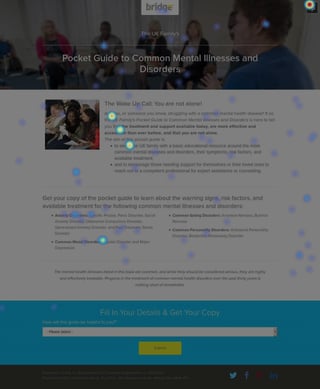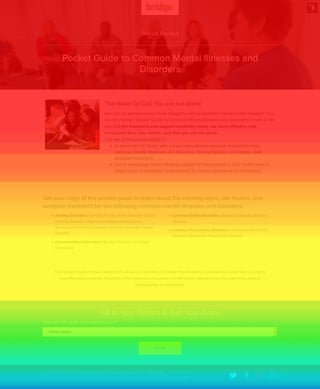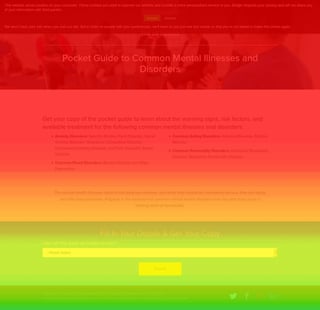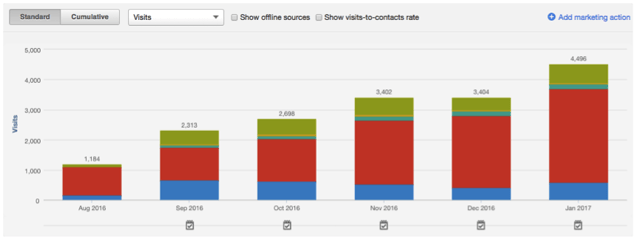Bridge reached out to Struto for help, signing up for a website redesign and Inbound Marketing services.
Challenges in Marketing Mental Health Services
As an organisation that relies on grants and contracts to offer support to those in need, Bridge has a range of hugely diverse target personas.
Reaching these personas, however, requires a delicate touch. The challenge they found themselves facing was how to create and execute marketing activities that fostered trust with current and future patients, while still managing to inspire the support of healthcare commissioners, partners and future donors.
Their second unique challenge lay in competing with international hospital groups and wellbeing institutes for search engine rank. When it comes to championing the cause, the organisations function as a unified team with a shared goal. When it comes to their offering of community-based mental health services, however, providers have to ensure that they've got top rank in local search results.
Since day one, one of Bridge's major strengths has been their dedication to creating expert content in an empathic tone of voice. Championing the cause of mental health and wellbeing, however, requires all hands on deck and Bridge decided to delegate their marketing projects to an agency with the strategic knowledge, technology, and talent to do right by their clients and supporters. Enter: Struto.
Taking Action: Creating Bridge’s Very First Marketing Campaign
Topic: Common Mental Illnesses & Disorders
Content offer: The UK Family’s Pocket Guide to Common Mental Illnesses & Disorders
Launch date: 1 December 2016
It was now up to us at Struto to solve the riddle of how to capture and nurture leads of potential supporters, without estranging people who reach out for support in their moment of vulnerability.
When we created Bridge’s new, inbound-enabled website earlier in the year, we focussed on making it a safe and reliable space in a world where mental health stigma prevails. Our inbound marketing campaigns also had to embody the value of trustworthiness and respect.
We did this because our Discover process highlighted Bridge's advantageous approach of working with individuals as whole human beings, instead of narrowly defining them as someone with a mental illness. As described by Bridge's CEO, Raymond Sheehy:
"What our team is particularly good at, is the one-to-one relationships with the people we work with. Starting off with building a relationship to establish trust that we’re truly with people in their journey to recovery."
Getting their Target Audience Right
Our first campaign would be focussed on supporting two of Bridge’s primary personas: people who are affected by mental illnesses themselves and the loved ones that support them in their recovery. While focusing on this audience as a first campaign would not necessarily generate funding, it was aligned to Bridge's
Identifying the Topics of Interest
Studies on the mental health of the UK population told a story of an increasing number of people diagnosed with common mental illnesses. Keyword research confirmed a tremendous interest in the topic.
We found that keywords relating to the most common mental illnesses received a staggering volume of searches in the UK, every month:
- "Anxiety": 95,000
- "Bipolar" and "bipolar disorder": 110,000
- "Personality disorder" and "borderline personality disorder": 62,600
- "Anorexia" and "eating disorders": 45,200
Creating awareness with content
In the journey towards requesting mental health support for yourself or someone you love, the awareness phase can be fraught with anxiety and confusion. Our content offer had to provide our personas with the valuable information they were searching for, but it also had to respond to the emotions that they were experiencing.
In response, the
- The offer was created as a ‘pocket guide’ that presents academically researched information in a format that the average reader can easily digest. Both the chapters that outline different categories of illnesses, and the subsections outlining specific disorders were created as stand-alone units. However much or little information a reader was ready for, the guide had them covered.
- A foreword by Bridge's CEO, Raymond Sheehy, to illustrate his personal dedication to support people whose lives and families are affected by mental illness.
- The guide’s introduction addressed the matters of stigma and uncertainty off the bat, reassuring readers that they were not alone, and that effective treatments are available.
- International data was supplemented with local statistics to illustrate the prevalence of common mental health conditions in the UK.
- The guide not only outlines common mental illnesses by definition and symptoms but also refers to the many, evidence-based treatment programs available for each condition.
- By making use of dependent form fields on the landing page form, individuals who self-identified as our target persona would not be required to submit any personal information to receive the offer.
Distributing the Content Offer for Wider Impact
Promoting the offer would be our second great challenge. By using HubSpot’s Content Strategy tool (beta feature), we gathered a range of subtopics to support a blog series around the topic cluster of common mental illnesses.
By blogging alone, we knew, we didn’t stand a chance of competing with the big boys in search results. To work around this, we created a highly-targeted Google AdWords campaign to deliver our offer to our personas, whenever they searched for one of the topics covered within.
Optimising to Real-Time Data
The campaign was launched, traffic was starting to trickle in, and yet our work was far from done. By setting up Hotjar to record a
Clicking and scrolling data revealed that visitors were spending too much time on reading the introductory comments, with 75% dropping off before reaching the submission form.


A month after launch, we decided to cut the image and introductory comments from the page. The shorter version of the same page had an immediate and enduring effect: 75% of users were now scrolling to below the form.

Another nagging concern on our minds was how our target personas interpreted the form on the landing page. Was there any way to reassure them that they would not be pressed to provide additional personal information once they had selected an option? Would we have to employ smart content on the landing page? Perhaps a special disclosure? We decided to experiment with a simple solution: adding the qualifier, “anonymously”, to the relevant persona descriptions.

The minor change paid off, taking submissions via paid advertising channels from 4.2% to 7.73% and those from social channels from 7.41% to a whopping 37.5%. Overall, the page’s conversion rate went up from 4.4% to 7.69%.
Campaign Results
Content offer downloads: 285 in three and a half months
Overall website traffic (monthly average):
- Before campaign launch: 2,400
- Since campaign launch (1 December): 4,700

Was it only for the data, we’d be satisfied with the growth and improvement in brand awareness and marketing content. What we didn't count on was the overwhelming number of submissions from people who volunteered their contact information and requested Bridge's support for themselves or a loved-one.
While the journey to improved mental health is an ongoing feat, we're delighted to have succeeded in helping Bridge to mirror their innate empathy and trustworthiness in their digital marketing communications.

